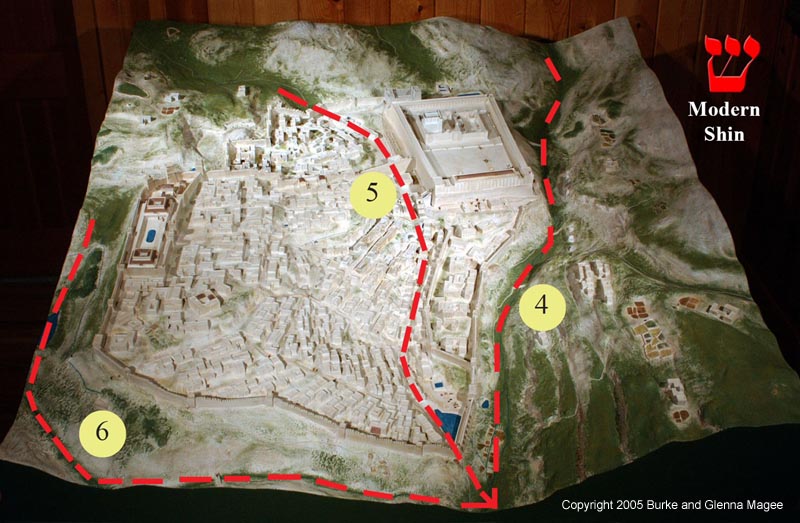

“Yea,
though I walk through the valley of the shadow of death,
I
will fear no evil: for thou art with me; thy rod and thy staff they
comfort me.” - Psalm 23:4
The valleys of Jerusalem
form the Hebrew letter Shin:
4 - Kidron Valley
5 - Tyropoeon Valley
6 - Hinnom Valley
Rubble from destroyed buildings had somewhat filled in the valleys even
in Yeshua's time.

4
Kidron Valley (Valley of the Shadow of Death)
During the Feast of Tabernacles at night, four enormous oil lamps burned
in the Temple courtyard. Each lamp had four large bowls of oil on tall
stands, with wicks made from worn-out garments of the priests. It is
written that “there was not a courtyard in
Jerusalem that did not reflect the light” (Mishnah, Sukkoth 5:3).
The lights could be seen throughout Jerusalem; however due to the depth
and angle, the Kidron Valley remained in shadow. The Kidron Valley has
many burial sites, since many believe that the resurrection will begin
there. For these reasons, it is said that the Kidron Valley was called
the “Valley of the Shadow of Death,” as in Psalm 23:4. David
likely wrote Psalm 23 when fleeing from his son, Absalom (a type of
the False Messiah), across
the Kidron Valley - 2 Samuel 15. Psalm 23 is likely a a prophetic reference
to the Messiah, Yeshua, who was arrested at the Garden of Gethsemane,
then brought to Jerusalem across the Kidron Valley. Yeshua likely prayed
Psalm 23 at that moment.
5
Tyropoeon Valley
The rugged Tyropoeon Valley separates Mount Moriah from Mount Zion and
was spanned by bridges, most notably Zion Bridge, connecting the royal
palace on Mount Zion to the Temple. A fragment of an arch of this bridge,
called “Robinson's Arch”, was discovered by historian Edward
Robinson in 1838.
6
Hinnom Valley
The name of the Hinnom Valley in Hebrew is GeHinnom, “Gehenna.”
Gehenna became associated with eternal torment (the lake of fire) because
detestable infant sacrifices to Molech took place there.
Gehenna is translated “hell” in the KJV (Matthew 5:22, 29).
Gehenna is the valley of slaughter that will be used in the future (end
times) as a place of slaughter, flames, and punishment for the wicked:
“Therefore, behold, the days come, saith
the LORD, that this place shall no more be called Tophet, nor The valley
of the son of Hinnom, but The valley of slaughter.” - Jeremiah
19:6.
“My
Name Shall be There...”
In 1 Kings 8:28-29, Solomon quotes the Lord as stating that His Name
shall be in the land where Solomon is to build the House of God:
“That thine eyes may be open toward
this house night and day, even toward the place of which thou hast said,
My name shall be there: that thou mayest hearken unto the prayer which
thy servant shall make toward this place.” -1
Kings 8:28-29
It is interesting that the three valleys form the Hebrew letter “Shin.”
A modern version of the Shin is shown in the picture below. The Shin
represents God’s name as in “El Shaddai” (God Almighty).
“Shaddai,” written in Hebrew ydc, denotes the character
of God, that He is Almighty. This is how God revealed Himself to the\
patriarchs in Exodus 6:2-3. The Shin likewise represents God’s
name and character on Mezzuzot that are placed on doorposts as commanded
in Deuteronomy 6:9: “And thou shalt write them upon the posts
of thy house, and on thy gates.”